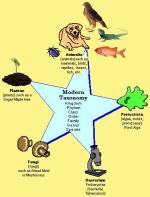|
This section contains 605 words (approx. 3 pages at 300 words per page) |

|
There are more than five million different species on Earth. While each species represents the end point of a unique evolutionary path, biologists do not treat each one as completely unrelated to the others. Instead, they have created biological classification systems, or taxonomies, to reflect similarities and differences among species. A taxonomy is hierarchical, meaning that groups, or taxa, are themselves members of larger groups. For example, birds and mammals are grouped together as vertebrates because they both have backbones. Jellyfish do not belong to the vertebrate taxon because they lack backbones. However, birds, mammals, and jellyfish all belong to the taxon Animalia.
The fundamental group in a biological taxonomy is the species. The most widely accepted definition of a species is "a group of actually or potentially interbreeding natural populations that are reproductively isolated from (unable to mate with) other such groups." In the eighteenth...
|
This section contains 605 words (approx. 3 pages at 300 words per page) |

|


